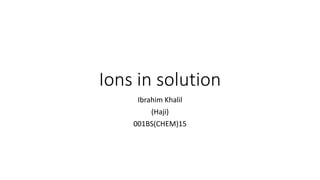
Ions in solution
- 1. Ions in solution Ibrahim Khalil (Haji) 001BS(CHEM)15
- 2. SYNOPSIS • Previous concept about the ionic compounds • Modern concept of ionic compound • Solution • Concentration of solution • Types of solution • Ionic aspect of solution • Migration of ions • Experimental view • Applications
- 3. Previous concept about the compounds • Early ideas of atoms and compounds, developed primarily through the reactions of solids and gases, did not include the concept of charge. Atoms and molecules were seen as neutral particles. However, as the study of chemistry progressed to include sols, new models were needed because the old models could not explain electrical conductivity. • Solutions of compounds like sugar did not increase the electrical conductivity of water, yet they had lower freezing points than pure water. • Solutions of compounds such as sodium chloride greatly affected the electrical conductivity of water, and they also caused the freezing point of the solution to be reduced twice as much as was observed in sugar water solutions.
- 4. Modern concept of compound • A new model that explained these observations was based on the concept that charged particles, which were called ions, formed in solutions. If compounds like sodium chloride broke apart into charged particles when in solution, the ions could carry electrical current. Substances such as sugar must not break into ions in solution because they did not conduct electricity. These studies of the characteristics of solutions led to a more complete and accurate understanding of chemistry at the particulate level.
- 5. Solution: A solution is a homogeneous mixture of two or more substances on molecular level. The constituent of the mixture present in a smaller amount is called the Solute and the one present in a larger amount is called the Solvent. For example, when a smaller amount of sugar (solute) is mixed with water (solvent), a homogeneous solution in water is obtained. In this solution, sugar molecules are uniformly dispersed in molecules of water. Similarly, a solution of salt (Na+ Cl–) in water consists of ions of salt (Na+,Cl–) dispersed in water.
- 6. CONCENTRATION OF A SOLUTION • The concentration of a solution is defined as the amount of solute present in a given amount of solution. • Expressing the concentration as: • A solution containing a relatively low concentration of solute is called Dilute solution. • A solution of high concentration is called Concentrated solution.
- 7. Types Of Solution • The common solutions that we come across are those where the solute is a solid and the solvent is a liquid. In fact, substance in any three states of matter (solid, liquid, gas) can act as solute or solvent. Thus there are seven types of solutions
- 9. Ionic Aspect Of Solution • Savante Arrhenius studied the conduction of current through water solutions of electrolytes. He came to believe that the conductivity of solutions was due to the presence of ions. In 1884, Arrhenius put forward his theory of ionisation. Arrhenius theory of ionisation may be stated as: • (1) When dissolved in water, neutral electrolyte molecules are split up into two types of charged particles. These particles were called ions and the process was termed ionisation. The positively charged particles were called cations and those having negative charge were called anions.
- 10. MIGRATION OF IONS • We know that electrolytes dissociate in solution to form positive ions (cations) and negative ions (anions).
- 11. Experimental view • As the current is passed between the electrodes of the electrolytic cell, the ions migrate to the opposite electrodes. Thus in the electrolytic solution of AgNO3, the cations (Ag+) will move to the cathode and anions (–3 NO) will move to the anode. Usually different ions move with different rates. The migration of ions through the electrolytic solution can be demonstrated by the following experiments.
- 12. Application • Adsorption • Colloids • Batteries • Etc
- 13. ?
